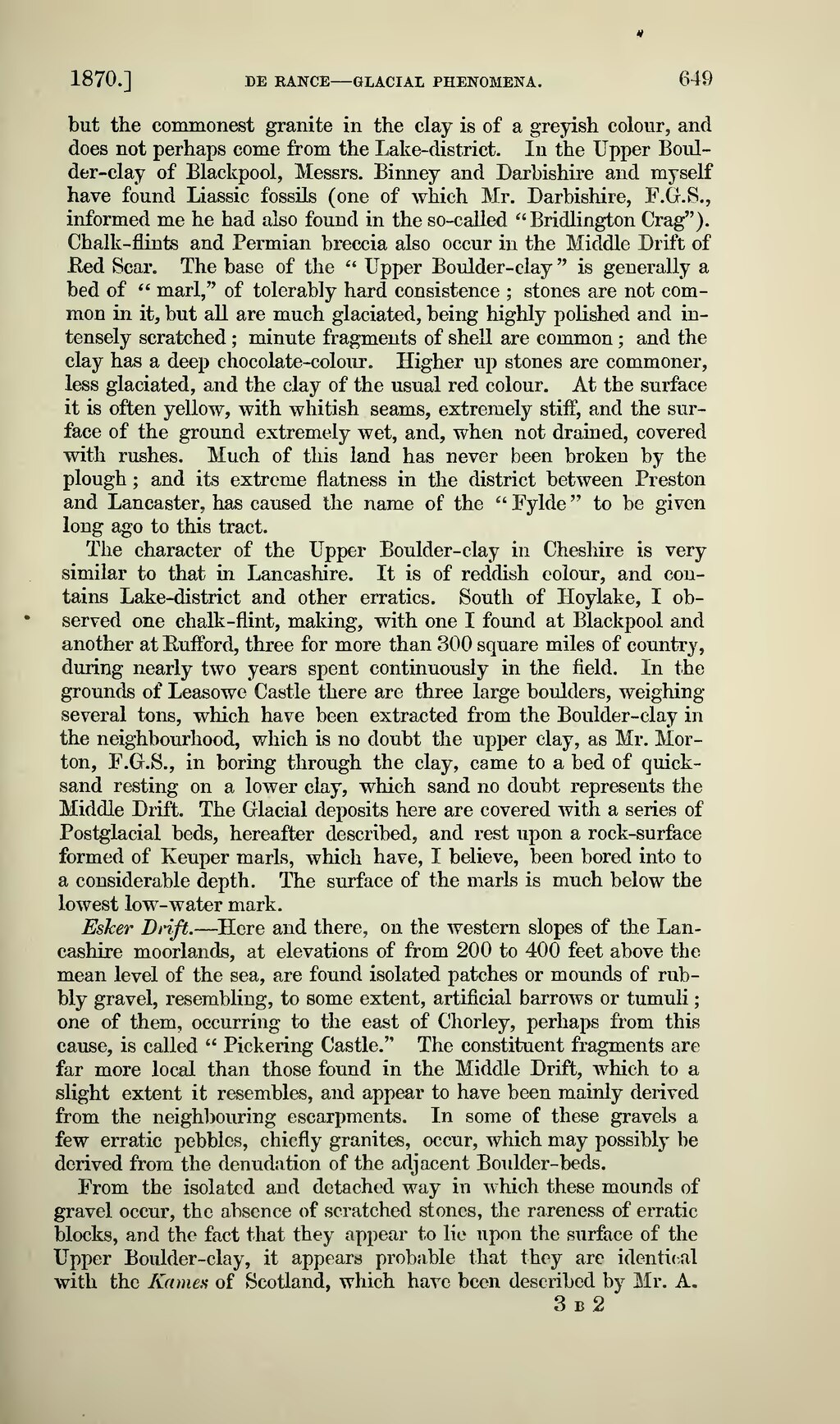but the commonest granite in the clay is of a greyish colour, and does not perhaps come from the Lake-district. In the Upper Boulder-clay of Blackpool, Messrs. Binney and Darbishire and myself have found Liassic fossils (one of which Mr. Darbishire, F.G.S., informed me he had also found in the so-called "Bridlington Crag"). Chalk-flints and Permian breccia also occur in the Middle Drift of Red Scar. The base of the " Upper Boulder-clay " is generally a bed of " marl," of tolerably hard consistence ; stones are not common in it, but all are much glaciated, being highly polished and intensely scratched ; minute fragments of shell are common ; and the clay has a deep chocolate-colour. Higher up stones are commoner, less glaciated, and the clay of the usual red colour. At the surface it is often yellow, with whitish seams, extremely stiff, and the surface of the ground extremely wet, and, when not drained, covered with rushes. Much of this land has never been broken by the plough ; and its extreme flatness in the district between Preston and Lancaster, has caused the name of the " Fylde " to be given long ago to this tract.
The character of the Upper Boulder-clay in Cheshire is very similar to that in Lancashire. It is of reddish colour, and contains Lake-district and other erratics. South of Hoylake, I observed one chalk-flint, making, with one I found at Blackpool and another at Rufford, three for more than 300 square miles of country, during nearly two years spent continuously in the field. In the grounds of Leasowe Castle there are three large boulders, weighing several tons, which have been extracted from the Boulder- clay in the neighbourhood, which is no doubt the upper clay, as Mr. Morton, F.G.S., in boring through the clay, came to a bed of quick-sand resting on a lower clay, which sand no doubt represents the Middle Drift. The Glacial deposits here are covered with a series of Postglacial beds, hereafter described, and rest upon a rock-surface formed of Keuper marls, which have, I believe, been bored into to a considerable depth. The surface of the marls is much below the lowest low- water mark.
Esker Drift. — Here and there, on the western slopes of the Lancashire moorlands, at elevations of from 200 to 400 feet above the mean level of the sea, are found isolated patches or mounds of rubbly gravel, resembling, to some extent, artificial barrows or tumuli ; one of them, occurring to the east of Chorley, perhaps from this cause, is called " Pickering Castle." The constituent fragments are far more local than those found in the Middle Drift, which to a slight extent it resembles, and appear to have been mainly derived from the neighbouring escarpments. In some of these gravels a few erratic pebbles, chiefly granites, occur, which may possibly be derived from the denudation of the adjacent Boulder-beds.
From the isolated and detached way in which these mounds of gravel occur, the absence of scratched stones, the rareness of erratic blocks, and the fact that they appear to lie upon the surface of the Upper Boulder-clay, it appears probable that they are identical with the Kames of Scotland, which have been described by Mr. A.
3 b 2
